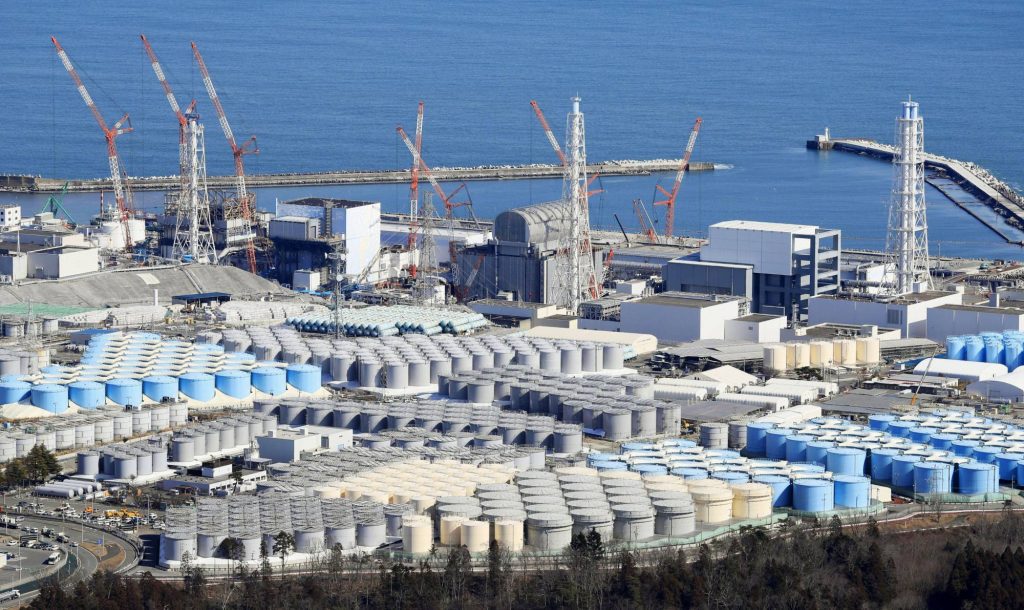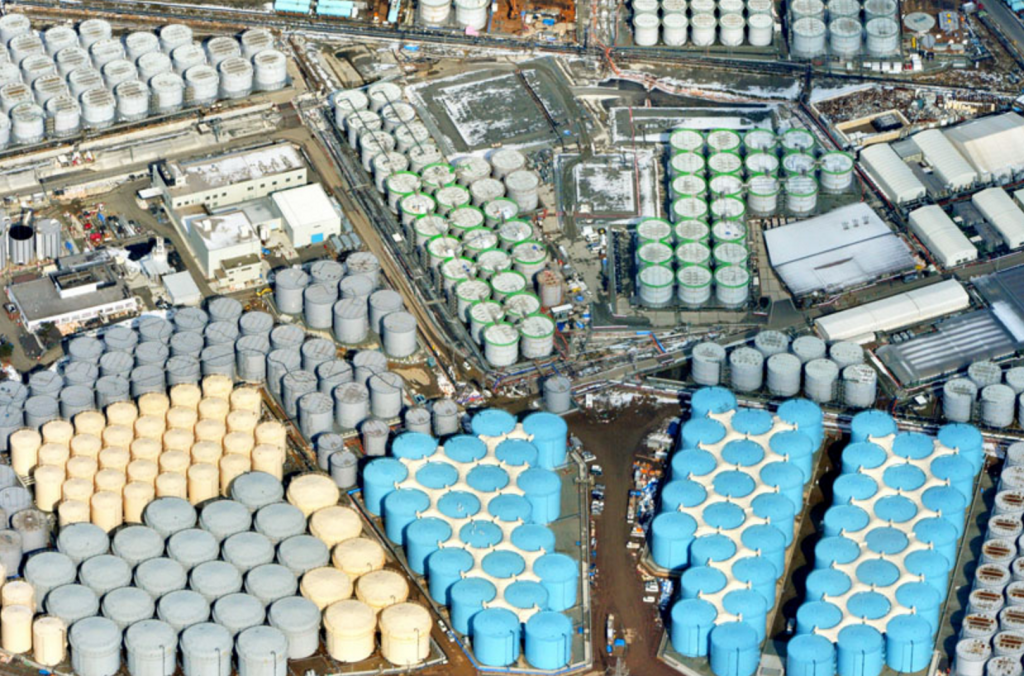Japan Govt./TEPCO Say Solution to Pollution is Dilution, as Plan to Dump Fukushima Wastewater to Pacific Moves Ahead

(EnviroNews World News) — Fukushima Prefecture, Japan — Japan’s Nuclear Regulation Authority has formally endorsed a controversial plan by TEPCO (Tokyo Electric Power Company) — the operator of the Fukushima Daiichi nuclear power plant — to start dumping more than a million tons of radioactive wastewater from the plant into the Pacific Ocean within the next two years. The plant was crippled in 2011 by an earthquake and tsunami that caused a disastrous triple meltdown. TEPCO claims it’s now running out of room to continue storing the wastewater onsite, but expert critics of the plan say that’s not really true.
The unprecedented disposal plan is expected to last for decades, with the wastewater to be pumped through a half mile long undersea tunnel that has yet to be constructed. The International Atomic Energy Agency (IAEA) signed off on the scheme last year, with IAEA Director General Rafael Mariano Grossi declaring that ocean disposal would be “both technically feasible and in line with international practice.” Yet, Grossi also admitted “the large amount of water at the Fukushima plant makes it a unique and complex case.”
This leaves opponents of the plan with no other regulatory recourse. Those opposed include Greenpeace Japan, human rights experts from the United Nations (UN), the government of China (which has deemed the strategy “extremely irresponsible”), as well as labor unions in the Japanese fishing industry.
Japanese fishermen fear that seafood will be contaminated by tritium in the wastewater — a radioactive isotope that cannot be removed through filtering. Japanese regulators have claimed the tritium will be diluted below 1/40th of the allowable level for discharge in Japan and to 1/7th of the World Health Organization’s (WHO) ceiling for drinking water.
The Japanese government has put forth a relief plan to assist the fishing industry, saying last year that it will create a fund to buy and store freezable seafood from fishermen whose sales drop due to reputational damage from the discharges from Fukushima. The details on the plan remain murky though, as does the wastewater’s potential damage to the food chain.

55 countries and regions including the United States imposed restrictions on the import of Japanese seafood in the wake of the Fukushima meltdowns, but only five of them still have import bans in place (China, South Korea, Taiwan, Hong Kong and Macau.)
EnviroNews reached out to the IAEA but the agency did not respond to a query about their endorsement of the controversial plan, while the U.S. Nuclear Regulatory Commission (NRC) predictably deflected toward the IAEA.
“The United States is confident the Government of Japan, in collaboration with the International Atomic Energy Agency, has weighed all available options and has taken all appropriate international guidelines into consideration in its decision-making process. We understand the IAEA will continue to work closely with the Government of Japan to ensure the adopted approach is in accordance with globally accepted nuclear safety standards,” U.S. NRC Public Affairs Officer Scott Burnell told EnviroNews by email.
Greenpeace has another view, condemning the dumping plan and insisting TEPCO’s claim about running out of storage space at Fukushima simply isn’t true.
In the wake of the IAEA’s endorsement of the scheme last year, Greenpeace Japan’s Climate/Energy Campaigner Kazue Suzuki said this:
The Japanese government has once again failed the people of Fukushima. The government has taken the wholly unjustified decision to deliberately contaminate the Pacific Ocean with radioactive wastes. It has discounted the radiation risks and turned its back on the clear evidence that sufficient storage capacity is available on the nuclear site as well as in surrounding districts. Rather than using the best available technology to minimize radiation hazards by storing and processing the water over the long term, they have opted for the cheapest option, dumping the water into the Pacific Ocean.
Several human rights experts from the United Nations’ Human Rights Council have also expressed concern and regret at Japan’s dumping strategy with the three Special Rapporteurs saying this in a statement last year:
Japan has noted that the levels of tritium are very low and do not pose a threat to human health. However, scientists warn that the tritium in the water organically binds to other molecules, moving up the food chain affecting plants and fish and humans. They say the radioactive hazards of tritium have been underestimated and could pose risks to humans and the environment for over 100 years.
Nuclear engineer and Fairewinds Energy Education board member Arnie Gundersen has visited the Fukushima site four times over the past decade and concurs with the Greenpeace assessment. In an interview with EnviroNews, he pointed out how the land next to the nuclear plant could be utilized for further storage of the contaminated water.
“There’s vast amounts of pasture land, immediately adjacent, that [are] highly contaminated… so they’re not going to use it for anything,” Gundersen told EnviroNews. “So, they could build more tanks, but it’s cheaper for them to dump it than to build more tanks.”
Gundersen also takes issue with TEPCO’s claim that the proposed dumping scheme will only involve a release of tritium, noting that there are still other radioactive isotopes of concern.
“They’re trying to portray this as a tritium release, but in fact there are other isotopes in the water in addition to tritium. There’s strontium and cesium and things like that,” Gundersen said. “The isotope of concern for me is Strontium 90, which is classified as an HDT – which stands for hard to detect.”
Gundersen noted that strontium is “a bone-seeker” that causes leukemia and is difficult to detect because it emits a beta particle that is similar to other elements emitted at the same frequency. As to the tritium, he noted that it’s naturally occurring in very low quantities so that measurements won’t find an appreciable increase 100 to 200 miles away from where TEPCO is planning the discharge. The dump-zone itself however, is another story.
“200 miles of ocean is an awful lot to contaminate because you’re too cheap to build more tanks,” Gundersen asserted. He pointed out that tritium has a 12-year half-life, meaning that the contamination level would decrease by 50 percent in 12 years, 75 percent in 24 years, and would be considered decayed by 120 years.
Gundersen says the IAEA’s claim that TEPCO’s dumping plan is in line with international practice is another blatant falsehood.
“It’s not in line with international practice. You’re talking about dumping a thousand tanks of thousands of tons [of contaminated wastewater] per tank into the ocean. Nobody’s doing that, it’s never been done,” Gundersen rebuffed, adding that the IAEA is more concerned about protecting the image of the nuclear power industry than they are about protecting the oceans and the food chain.
Gundersen discusses the severity of contamination to the Pacific by Fukushima on EnviroNews
“The IAEA is a handmaiden to the nuclear industry. Article II of the IAEA charter is to promote nuclear power, so you’re not getting an objective analysis,” Gundersen laments.
Robert H. Richmond, a research professor and Director of the Kewalo Marine Laboratory at the University of Hawaii, voiced similar concerns earlier this summer in an article for CodeBlue:
Claims of safety are not scientifically supported by the available information. The world’s oceans are shared among all people, providing over 50 per cent of the oxygen we breathe, and a diversity of resources of economic, ecological and cultural value for present and future generations. Within the Pacific Islands in particular, the ocean is viewed as connecting, rather than separating, widely distributed populations. Releasing radioactive contaminated water into the Pacific is an irreversible action with transboundary and transgenerational implications. As such, it should not be unilaterally undertaken by any country.
Richmond went on to call for a more prudent approach adhering to precautionary principles. “The rush to dilute and dump is ill-advised and such actions should be postponed until further due diligence can be performed,” he said. “Sound science, and a much more careful consideration of the alternatives, and respect for the health and well-being of the peoples of the Pacific region, all demand it,” Richmond concluded.
FILM AND ARTICLE CREDITS
- Greg Schwartz - Journalist, Author



